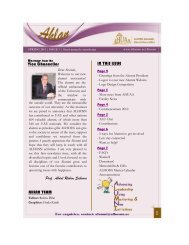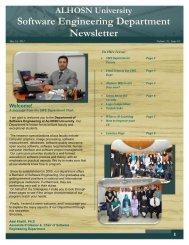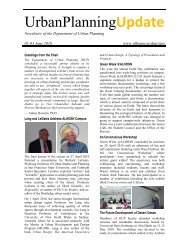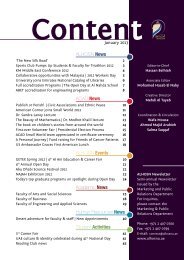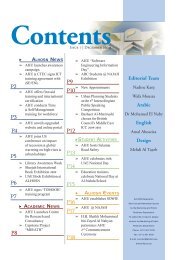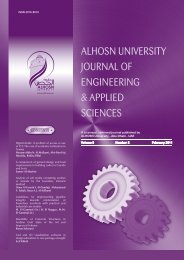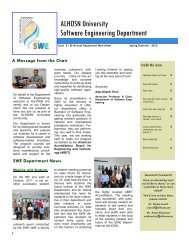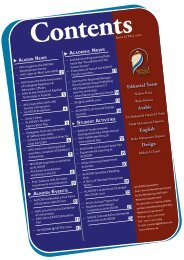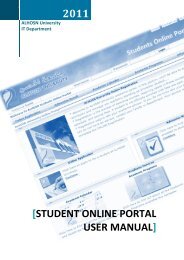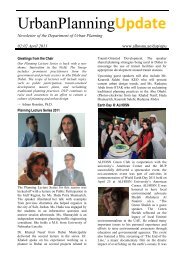ALHOSN University Catalogue Global Knowledge with Local Vision ...
ALHOSN University Catalogue Global Knowledge with Local Vision ...
ALHOSN University Catalogue Global Knowledge with Local Vision ...
Create successful ePaper yourself
Turn your PDF publications into a flip-book with our unique Google optimized e-Paper software.
the student and the advisor, compatible <strong>with</strong> the student’s career interests and academic<br />
records, as well as available information on the frequency of course offerings and possible<br />
scheduling conflicts.<br />
9. Help students re-think the course of study in the event that their interests change, refer students<br />
to an appropriate source for improvement of study and other skills when necessary.<br />
10. Relay information about available activities that may enhance student’s learning experiences.<br />
Statement of Advisor Expectations<br />
Members of the <strong>ALHOSN</strong> <strong>University</strong> faculty accept the responsibility of being informed and<br />
concerned about students assigned to them as advisees. Advising involves helping students move<br />
through a sequential decision-making process toward realistic, flexible academic and professional<br />
goals. In order for faculty advisors to provide this service, it is expected that each student will:<br />
1. Consult <strong>with</strong> his/her advisor at least once a semester;<br />
2. Make appointments for such counseling during office hours.<br />
3. Respect appointments time. If the student finds that it is impossible to keep the<br />
appointment, he/she should notify his/her advisor before the appointed time.<br />
4. Discuss academic and career-related needs as they develop.<br />
5. Be prepared for the appointment and bring appropriate materials and documents.<br />
6. Seek assistance <strong>with</strong> decisions to be made rather than expect the advisor to make them.<br />
7. Follow through <strong>with</strong> appropriate action after the advising session, or consult <strong>with</strong> the advisor<br />
if critical decisions cannot be accomplished.<br />
8. Seek additional counsel from other appropriate sources.<br />
9. Evaluate advising sessions and give feedback to the advisor in order to strengthen the<br />
advising process.<br />
10. Seek reassignment to another advisor when appropriate.<br />
Add/Drop Courses Regulations<br />
Adding a Course<br />
Students may add courses to their schedules until the published add/drop day. Students cannot add<br />
courses after that date. See academic calendar for the last day to add courses.<br />
Dropping a Course<br />
It is the student’s responsibility to officially drop a course. When dropping a course <strong>with</strong>in three<br />
calendar weeks from the date when classes begin, no grade will appear on the student’s record. When a<br />
student drops a course after the third week of class and before the end of the 8th week of class, a grade<br />
of “W” will be recorded on the student’s academic record. When a student drops a course after the 8th<br />
week of class, he/she will receive an F grade.<br />
Transfer <strong>with</strong>in <strong>University</strong> Faculties<br />
First-Semester Students<br />
First-semester students may apply to transfer <strong>with</strong>in the university from one specialization to another<br />
during the drop- add period. This application is processed through the Admissions and Registration<br />
Office in accordance <strong>with</strong> the following conditions:<br />
1. The applicants should meet the admission requirements of the field of specialization where<br />
they are transferring.<br />
2. There is availability of vacancies in the specialization where they are transferring.<br />
3. There is approval of the two faculties/ departments concerned.<br />
Regular Students<br />
Regular students may transfer from one specialization (major) to another <strong>with</strong>in the university provided<br />
that they fulfill items 2 and 3 above, in addition to the following:<br />
1. They should have completed at least one full semester in the university.<br />
2. Each student is entitled to one transfer only throughout his/her course of study at the university.<br />
3. The last semester average should be equivalent to the new specialization requirements.<br />
4. The number of semester credits a student can carry to the new specialization is limited to 60<br />
credit hours.<br />
27



